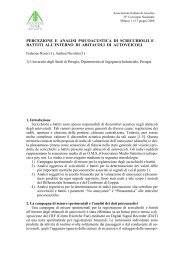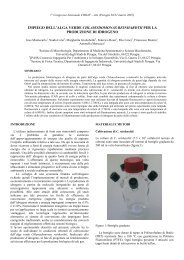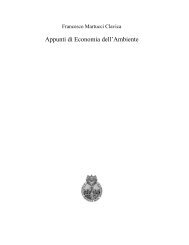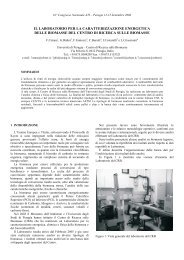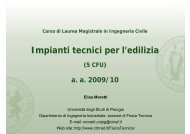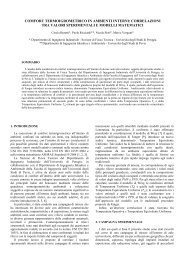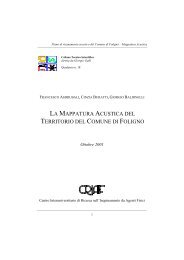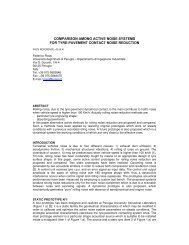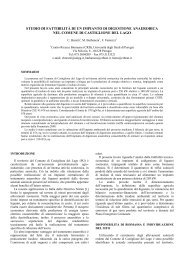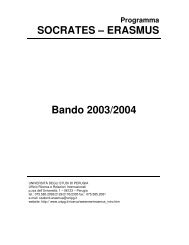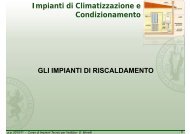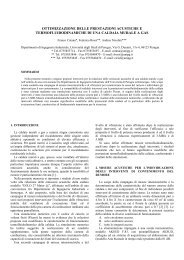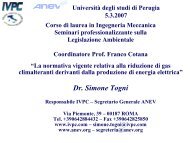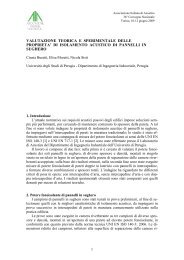Investigation on a ionic liquid matrix for decreasing MCFC ... - CIRIAF
Investigation on a ionic liquid matrix for decreasing MCFC ... - CIRIAF
Investigation on a ionic liquid matrix for decreasing MCFC ... - CIRIAF
You also want an ePaper? Increase the reach of your titles
YUMPU automatically turns print PDFs into web optimized ePapers that Google loves.
A pressurizati<strong>on</strong> system allows keeping the gases compartments at a pressure 50mbar higher thanthe LT<strong>MCFC</strong> <strong>on</strong>e; this adjustment increases the electrolyte soluti<strong>on</strong> tight. The experimental facilityis made by the reactor, a gas supplying system and a heating system. The heating system is madeby a thermostatic bath c<strong>on</strong>stituted by silic<strong>on</strong> oil in a steel box. An electromagnetic agitator andheater allows the bath uni<strong>for</strong>m heating. Besides, the facility was thermally insulated during the testsin order to minimize the thermal dispersi<strong>on</strong>s. The facility is shown in Figure 3.Figure 3 – the experimental facilityThe experimental testsExperimental tests were made by the facility with different electrolyte soluti<strong>on</strong>s c<strong>on</strong>stituted byi<strong>on</strong>ic <strong>liquid</strong>s and carb<strong>on</strong>ates. Two kinds of i<strong>on</strong>ic <strong>liquid</strong>s were tested (identified by IL1 and IL2codes). Their characteristics in terms of kinematic viscosity (measured by Ubbelohde viscosimeterssoaked into thermostatic baths) and electrical c<strong>on</strong>ductivity (measured by a c<strong>on</strong>ductivimeter) areshown in Table 1. The tested electrolyte soluti<strong>on</strong>s were made by the i<strong>on</strong>ic <strong>liquid</strong>s (solvent) andcarb<strong>on</strong>ates (solute) 5% or 9.7% by weight. It was verified that carb<strong>on</strong>ates mixing does not modifythe electrical c<strong>on</strong>ductivity of the i<strong>on</strong>ic <strong>liquid</strong>s.Table 1: the tested i<strong>on</strong>ic <strong>liquid</strong>s characteristicsKinematic viscosity at 25°C Electrical c<strong>on</strong>ductivity at 25°CI<strong>on</strong>ic <strong>liquid</strong>(m 2 /s)(S/m)IL1 3.46*10 -4 0,02IL2 3.87*10 -5 0,12Tests were made <strong>for</strong> three LT<strong>MCFC</strong> temperatures: 50, 100 and 150 °C. Open-circuit voltages weremeasured and electrical loads were applied to measure the electrical current <strong>on</strong> a closed circuit. Forbrevity, Table 2 reports <strong>on</strong>ly open-circuit voltages, 1.5 ohm load voltages and 1.5 ohm loadcurrents. Results shows that <strong>on</strong>ly IL1 allows the LT<strong>MCFC</strong> working. IL2 applicati<strong>on</strong> does not



